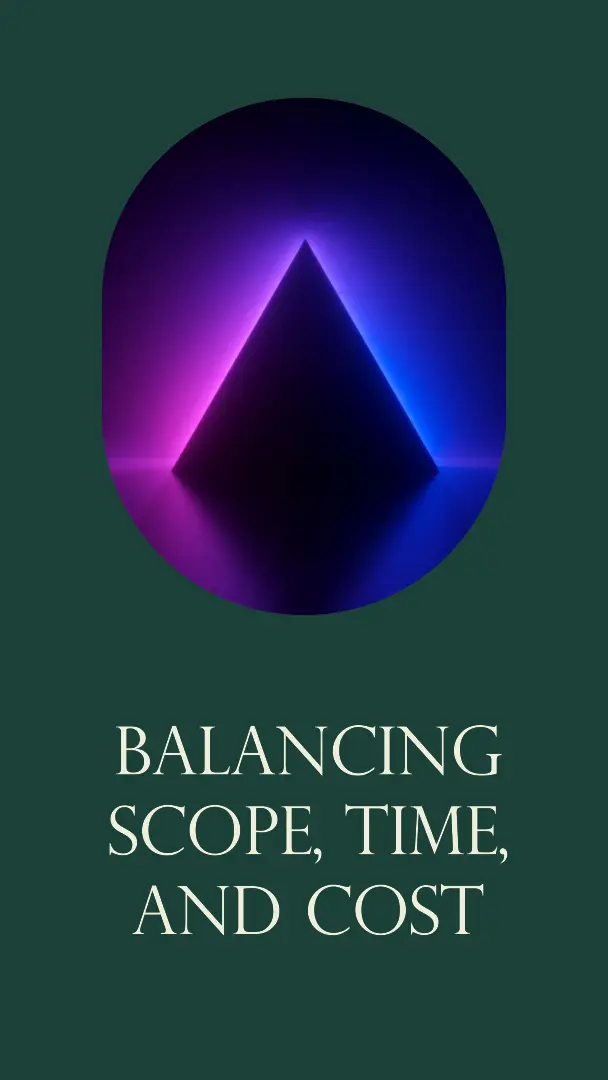To find out how Artificial Intelligence is changing the Project Management landscape, you may enjoy reading this article https://www.shaunstoltz.com/did-artificial-intelligence-just-change-everything-about-project-management/
I. Introduction
Welcome, fellow project management enthusiasts! Today, we’re diving into the fascinating world of the Golden Triangle, a fundamental concept that plays a critical role in the success of projects across industries. I’ll share with you the importance of project management in today’s competitive environment, introduce you to the golden triangle, and explore why balancing scope, time, and cost is absolutely essential for achieving project success.
A. The importance of project management in today’s competitive environment
Let’s face it: the world is moving at a breakneck pace. With rapid advancements in technology, increased globalization, and constantly evolving customer expectations, businesses are under immense pressure to deliver top-notch projects that meet these demands. That’s where project management comes into play. It’s the glue that holds all the moving parts together and ensures that we, as project managers, can guide our projects from start to finish, with everyone on the same page and working towards a common goal.
B. Introducing the golden triangle concept
Imagine a triangle, with each corner representing one of the three vital elements of any project: scope, time, and cost. This is the “Golden Triangle” of project management. It’s the balance of these three elements that determines the success or failure of a project. Striking the right balance can be tricky, but when done effectively, it can lead to project success, stakeholder satisfaction, and a sense of accomplishment for the entire team.
C. The significance of balancing scope, time, and cost for project success
Picture this: your project is progressing smoothly, but suddenly there’s a change in scope. The client wants additional features, but they don’t want to budge on the deadline or the budget. What do you do? This is where the art of balancing the golden triangle comes into play. By understanding the intricate relationship between scope, time, and cost, and knowing how to adjust them when necessary, you’ll be well-equipped to navigate these challenges and steer your project towards success.
So, are you ready to delve deeper into the world of the golden triangle and learn how to master the delicate balance of scope, time, and cost? Join me as we explore each of these essential elements, discuss strategies for maintaining balance, and share real-world examples that demonstrate the power of the golden triangle in action. Let’s get started!
II. Understanding the Golden Triangle
As we continue our journey into the realm of the Golden Triangle, it’s crucial to grasp the fundamental concepts of scope, time, and cost, and their interdependent relationship. Understanding these elements will empower you to make informed decisions and achieve project success, even when faced with unexpected challenges. So let’s dive in and unravel the mysteries of the Golden Triangle!
A. Definition of scope, time, and cost
- Scope: In the simplest terms, the scope of a project is the sum of all the work that needs to be done to achieve the desired outcome. It’s the boundaries that define what is and isn’t part of the project, including objectives, deliverables, and requirements.
- Time: Time is a critical component of any project. It refers to the duration required to complete all the tasks and activities in the project plan, from kick-off to wrap-up. Proper time management ensures that projects are completed on schedule, keeping stakeholders happy and maintaining team morale.
- Cost: Last but not least, cost encompasses the financial resources needed to execute the project successfully. This includes everything from labor and materials to equipment and contingencies. Managing cost effectively ensures that the project stays within budget and delivers value to the organization.
B. The interdependent relationship between the three elements
Now that we have a clear understanding of scope, time, and cost, let’s talk about their interconnectedness. You see, when one of these elements changes, it inevitably impacts the others. For instance, if the scope expands to include more tasks or features, the time and cost of the project will likely increase as well. Similarly, if a project’s timeline is shortened, costs may rise due to the need for additional resources or overtime.
C. The consequences of imbalance in the golden triangle
When the balance of the Golden Triangle is disrupted, it can lead to a host of issues. A project that spirals out of control in terms of scope, time, or cost can result in missed deadlines, budget overruns, and unhappy stakeholders. In some cases, it might even lead to the dreaded “project failure.” But fear not, my fellow project managers! By recognizing the delicate balance between scope, time, and cost, and implementing effective strategies to maintain that balance, you can avoid these pitfalls and achieve project success.
Stay tuned as we explore each element of the Golden Triangle in detail and share practical tips for maintaining balance, ensuring your projects run smoothly and exceed expectations. Together, let’s conquer the world of project management and master the art of the Golden Triangle!
III. Balancing Scope
Congratulations on making it this far in our Golden Triangle adventure! Now that we have a solid understanding of the fundamental concepts, it’s time to take a closer look at each element, starting with scope. In this section, we’ll explore strategies for defining and managing scope, so you can keep your project on track and deliver the results your stakeholders expect.
A. Defining clear project objectives and requirements
First and foremost, it’s crucial to establish clear and well-defined project objectives and requirements. This involves working closely with stakeholders to understand their needs and expectations, as well as any constraints or limitations. By starting with a comprehensive understanding of the project’s purpose, you’ll be better equipped to create a detailed project plan that outlines the work required to achieve those objectives.
B. Utilizing a work breakdown structure (WBS)
One of my favorite tools for managing project scope is the work breakdown structure (WBS). A WBS is a hierarchical breakdown of the project’s scope into smaller, manageable components, such as tasks and deliverables. By creating a WBS, you can visualize the entire scope of the project, which makes it easier to monitor progress, identify potential risks, and ensure that all tasks are accounted for. Plus, it’s a great way to communicate the project plan to your team and stakeholders!
C. Managing scope creep and change requests
Ah, scope creep – the bane of every project manager’s existence! Scope creep occurs when additional tasks or features are added to the project after it has already begun, without corresponding adjustments to the schedule or budget. To keep scope creep at bay, it’s essential to establish a formal change request process that requires stakeholders to submit and justify any proposed changes to the project scope. By carefully evaluating and approving change requests, you can maintain control over your project’s scope and avoid unpleasant surprises down the line.
D. Tips for maintaining scope balance
- Foster open communication: Encourage your team members and stakeholders to voice their concerns and ideas throughout the project. This helps to identify potential scope issues early on, so you can address them proactively.
- Be flexible, but firm: It’s important to strike a balance between accommodating stakeholder requests and maintaining the integrity of the project’s scope. Be willing to consider changes, but stand firm when it comes to protecting the project’s objectives and deliverables.
- Review and adjust regularly: Regularly review the project’s scope, progress, and any potential risks. This allows you to make adjustments as needed and ensures that your project stays on track.
Now that we’ve tackled the intricacies of scope management, it’s time to move on to the next element of the Golden Triangle: time. In the next section, we’ll explore strategies for balancing time to ensure your projects are completed on schedule and within budget. Stay tuned, and let’s continue our journey towards project management mastery!
IV. Balancing Time
Welcome back, project management trailblazers! With scope under our belts, it’s time to tackle the next crucial element of the Golden Triangle: time. In this section, we’ll delve into the importance of realistic project scheduling, explore project management tools and methodologies, and share tips for maintaining time balance in your projects.
A. The importance of realistic project scheduling
Time management is a cornerstone of successful project management. To complete your project on schedule, it’s vital to create a realistic project timeline that accounts for all tasks, dependencies, and potential risks. By establishing a well-thought-out schedule, you’ll ensure your team has a clear understanding of the project’s timeline, milestones, and deadlines, which helps to keep everyone focused and on track.
B. Utilizing project management tools and methodologies (e.g., Gantt charts, critical path method)
One of the best ways to manage project time effectively is to leverage project management tools and methodologies. Two of my favorites are Gantt charts and the critical path method (CPM).
- Gantt charts: A Gantt chart is a visual representation of the project schedule, displaying tasks, durations, and dependencies. This easy-to-read format allows you to quickly identify potential bottlenecks and monitor progress, ensuring that your project stays on schedule.
- Critical path method (CPM): CPM is a project scheduling technique that helps you identify the sequence of tasks with the least amount of scheduling flexibility, known as the critical path. By focusing on the critical path, you can allocate resources effectively and ensure that your project remains on schedule, even when faced with delays or unexpected challenges.
C. Managing project risks and delays
No project is immune to risks and delays, but by proactively identifying and addressing potential issues, you can minimize their impact on your project’s timeline. This involves conducting regular risk assessments, developing contingency plans, and being prepared to make adjustments to your project schedule as needed.
D. Tips for maintaining time balance
- Break tasks into manageable chunks: Break down large tasks into smaller, more manageable sub-tasks, making it easier to estimate durations and monitor progress.
- Monitor progress regularly: Keep a close eye on your project’s progress and address any potential delays or issues as soon as they arise.
- Communicate with your team: Maintain open lines of communication with your team members to ensure everyone is aware of their responsibilities and deadlines.
- Be prepared to adapt: Be willing to adjust your project schedule as needed to address unexpected challenges and keep your project on track.
Now that we’ve conquered time management, it’s time to move on to the final element of the Golden Triangle: cost. In the next section, we’ll dive into budgeting, expense monitoring, and strategies for maintaining cost balance in your projects. Stay tuned as we complete our journey towards mastering the art of the Golden Triangle!
V. Balancing Cost
Hello again, fellow project management enthusiasts! We’ve explored scope and time, and now it’s time to tackle the final element of the Golden Triangle: cost. In this section, we’ll discuss the role of budgeting in project management, share strategies for monitoring and controlling expenses, and provide tips for maintaining cost balance in your projects.
A. The role of budgeting in project management
Budgeting is an essential component of successful project management. By creating a detailed and realistic budget, you’ll provide your team with a clear understanding of the financial resources available for the project, as well as the cost constraints they must adhere to. A well-planned budget also allows you to track expenses throughout the project, helping to prevent cost overruns and ensuring that your project remains financially viable.
B. Monitoring and controlling project expenses
Keeping a close eye on project expenses is crucial to maintaining cost balance. This involves regularly reviewing expenses to ensure they align with the project budget, and identifying any discrepancies or potential issues. To stay on top of your project’s financial health, consider implementing the following strategies:
- Establish a cost baseline: A cost baseline is a snapshot of your project’s approved budget, which you can use to compare against actual expenses throughout the project.
- Track expenses in real-time: Use project management software or other tools to track expenses as they occur, ensuring that you always have an accurate picture of your project’s financial status.
- Implement cost control measures: Establish processes for monitoring and controlling expenses, such as requiring team members to obtain approval for any expenditures that exceed the budget.
C. Managing cost overruns and unexpected costs
Despite your best efforts, cost overruns and unexpected expenses can still occur. The key to managing these situations is to identify them as early as possible and take action to mitigate their impact on the project. This might involve adjusting the project scope, reallocating resources, or seeking additional funding from stakeholders.
D. Tips for maintaining cost balance
- Involve your team in the budgeting process: By engaging team members in the development of the project budget, you can ensure that they have a clear understanding of the financial constraints and are more likely to make cost-effective decisions.
- Regularly review and adjust the budget: As the project progresses, be prepared to review and adjust the budget to account for any changes in scope, schedule, or other factors that may impact the project’s cost.
- Communicate with stakeholders: Keep stakeholders informed of the project’s financial status and any potential issues that may impact the budget, so they can provide support and guidance as needed.
With cost management under our belts, we’ve now explored all three elements of the Golden Triangle! In the next section, we’ll take a look at real-world examples of successful Golden Triangle implementation, demonstrating the power of balancing scope, time, and cost in action. Join me as we wrap up our journey and celebrate our newfound project management prowess!
VI. Real-World Examples of the Golden Triangle in Action
As we reach the end of our Golden Triangle journey, I’d like to share some real-world examples of projects that have successfully balanced scope, time, and cost. By examining these cases, we can gain valuable insights into the practical application of the Golden Triangle principles and celebrate the achievements of project managers who have mastered this delicate balance.
A. Example 1: A software development project
In this example, a software development company was tasked with building a custom application for a client within a tight deadline and a fixed budget. The project manager recognized the importance of the Golden Triangle and took several steps to maintain balance:
- Clearly defined the project scope, including the features and functionality required by the client.
- Developed a detailed project schedule, using Gantt charts to visualize the timeline and critical path.
- Established a comprehensive budget, allocating resources and funds strategically to ensure the project remained within the financial constraints.
By staying vigilant and making adjustments as needed, the project manager successfully delivered the application on time, within budget, and with all the required features, earning the praise of both the client and the software development team.
B. Example 2: A construction project
In this case, a construction company was hired to build a new office facility. The project had a strict deadline and a limited budget, but the project manager rose to the challenge by:
- Collaborating with stakeholders to define the project scope, including the building’s design, size, and materials.
- Utilizing the critical path method to identify and prioritize the most time-sensitive tasks and milestones.
- Monitoring costs closely, implementing cost control measures, and keeping stakeholders informed of the project’s financial status.
Despite facing several unexpected challenges, including bad weather and material shortages, the project manager successfully balanced scope, time, and cost, ultimately completing the project on schedule and within budget.
C. Lessons learned from real-world examples
These examples demonstrate that, by applying the principles of the Golden Triangle and maintaining a keen focus on balancing scope, time, and cost, project managers can achieve remarkable success in their projects. Key takeaways include the importance of clear communication, proactive risk management, and adaptability in the face of challenges.
As we conclude our Golden Triangle exploration, I hope you’ve found this journey as enlightening and inspiring as I have. Armed with the knowledge and strategies we’ve discussed, I’m confident that you’ll be well-equipped to tackle your next project with skill and finesse. Thank you for joining me on this adventure, and here’s to mastering the art of the Golden Triangle in your project management endeavors!
VII. Conclusion and Next Steps
Well, my fellow project management aficionados, we’ve reached the end of our Golden Triangle expedition. I hope our journey together has been both informative and inspiring, equipping you with the knowledge and strategies you need to skillfully balance scope, time, and cost in your future projects.
As we bid farewell to the Golden Triangle, I encourage you to reflect on the insights we’ve shared and consider the following next steps in your project management journey:
A. Apply the Golden Triangle principles to your projects
Now that you’re familiar with the concepts of scope, time, and cost, put them into practice in your own projects. By actively applying the Golden Triangle principles, you’ll not only improve your project management skills but also increase the likelihood of project success.
B. Continue learning and growing
The world of project management is constantly evolving, and there’s always more to learn. Keep honing your skills by reading articles, attending workshops, joining professional organizations, or even pursuing certifications. The more you know, the better equipped you’ll be to handle the challenges that come your way.
C. Share your knowledge with others
As you become more adept at managing the Golden Triangle, consider sharing your wisdom with your colleagues, team members, and even your stakeholders. By fostering a culture of learning and growth, you’ll not only help others succeed but also create an environment where everyone can thrive.
D. Embrace the power of collaboration
Finally, remember that project management is a team sport. Encourage open communication, involve your team in decision-making, and collaborate with stakeholders to ensure everyone is on the same page. When everyone works together towards a common goal, amazing things can happen!
Thank you for joining me on this incredible adventure through the Golden Triangle. I’m confident that you’re now well-equipped to tackle the challenges of project management with skill, determination, and a newfound appreciation for the delicate balance of scope, time, and cost. Here’s to your continued success in mastering the art of the Golden Triangle – and to many more triumphant project management victories in the future!
Find out more about Shaun Stoltz https://www.shaunstoltz.com/about/
This post was written by an AI and reviewed/edited by a human.



